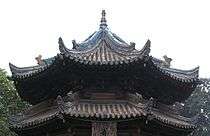Liu Zhi (scholar)
Liu Zhi (Xiao'erjing: ﻟِﯿَﻮْ جِ, ca. 1660 – ca. 1739), or Liu Chih, was a Chinese Sunni Muslim scholar of the Qing dynasty,[1] belonging to the Huiru (Muslim) school of Neoconfucian thought.[2] He was the most prominent of the Han Kitab writers who attempted to explain Muslim thought in the Chinese intellectual climate for a Hui Chinese audience, by frequently borrowing terminologies from Buddhism, Taoism and most prominently Neoconfucianism and aligning them with Islamic concepts. He was from the city of Nanjing.[3] His magnum opus, T'ien-fang hsing-li or 'Nature and Principle in the Direction of Heaven', was considered the authoritative exposition of Islamic beliefs and has been republished twenty-five times between 1760 and 1939, and is constantly referred to by Muslims writing in Chinese.[4]
| Liu Zhi | |||||||
|---|---|---|---|---|---|---|---|
Tomb of Liu Zhi in Yuhuatai District, Nanjing | |||||||
| Traditional Chinese | 劉智 | ||||||
| Simplified Chinese | 刘智 | ||||||
| |||||||
| Jielian (courtesy name) | |||||||
| Chinese | 介廉 | ||||||
| |||||||
| Yizhai (pseudonym) | |||||||
| Traditional Chinese | 一齋 | ||||||
| Simplified Chinese | 一斋 | ||||||
| |||||||
| Part of a series on Islam in China | ||||||
|---|---|---|---|---|---|---|
 | ||||||
|
||||||
|
| ||||||
Biography
In his childhood, he received instruction from his father, Liu Sanjie (劉三杰). At the age of 12, he studied scriptures with Yuan Ruqi (袁汝契) at the Garden of Military Studies Mosque in Nanjing, (which no longer exists). At the age of 15, he began a career of study in his home: for fifteen years, he read up on Confucianism, Buddhism, Daoism and "Western Studies." He considered Confucius and Mencius to be "Sages of the East" and Muhammad to be a "Sage of the West," and that "the teachings of the Sages of East and West, today as in ancient times, are one." He further believed that the scriptures of Islam are also "generally similar to the intentions of Confucius and Mencius." From around the age of 30, he took up residence at the foot of Qingliangshan in Nanjing, where he began to interpret and expound on the Islamic scriptures, using Confucian studies, for a period of about twenty years. During this time, he twice brought his manuscript with him to visit and solicit advice and the opinions of both Muslims and non-Muslims, leaving his tracks throughout Jiangsu, Shandong, Hebei, Henan, Anhui, Zhejiang, Guangdong, and other places. In his later years, he resided at his studio, Saoyelou ("House of Sweeping Leaves"), at Qingliangshan in Nanjing.
He learned Arabic and studied both Buddhism and Daoism. He also wrote several works on Islam in 1674, 1710, and 1721.[5]
His writings became part of the Han Kitab, a collection of literature which synthesized Islam and Confucianism.
He said that Muslims were allowed to believe in the Mandate of Heaven and serve the Emperor, because Allah allowed the Mandate of Heaven to exist.[6]
Works
- 天方性理 (Tianfang Xingli, The Metaphysics of Islam or The Philosophy of Arabia) T'ien-fang hsing-li . Šarḥ al-laṭā'if (شرح اللطائف) was the Arabic translation by Ma Lianyuan 馬聯元 1841-1903 (Muḥammad Nūr al-Ḥaqq ibn Luqmān as-Ṣīnī) (محمد نور الحق إبن لقمان الصيني)[7][8]
- 天方典禮 (Tianfang Dianli, The Rites of Islam)[9] T'ien fang tien li[10]
- 天方字母解義 (Tiānfāng zìmǔ jiě yì, Arabic Script explanation meaning) T'ien fang tse mu kieh i
- 天方至聖實綠 (Tianfang Zhisheng Shilu, The Real Record of the Last Prophet of Islam)[1] In 1921 it was translated into English by Royal Asiatic Society member Isaac Mason as "The Arabian Prophet : A Life of Mohammad from Chinese Sources".
See also
- Wang Daiyu, Chinese Islamic scholar, considered the first Han Kitab writer.
- Yusuf Ma Dexin, a later Chinese Islamic philosopher and reformist.
References
- Hagras, Hamada (2019-12-20). "THE MING COURT AS PATRON OF THE CHINESE ISLAMIC ARCHITECTURE: THE CASE STUDY OF THE DAXUEXI MOSQUE IN XI'AN". SHEDET (6): 134–158. doi:10.36816/shedet.006.08.
- Friendship in Confucian Islam, Sachiko Murata
- See generally: William Chittick with Sachiko Murata and Tu Weiming, The Sage Learning of Liu Zhi: Islamic Thought in Confucian Terms (Harvard University 2009).
- http://www.ibnarabisociety.org/articles/islamicneoconfucianism.html
- Paul Lunde (July–August 1985). "Muslims in China". SAUDI ARAMCO World.
- Masumi, Matsumoto. "The completion of the idea of dual loyalty towards China and Islam". Archived from the original on 2011-07-24. Retrieved 2010-06-28.
- Kees Versteegh; Mushira Eid (2005). Encyclopedia of Arabic Language and Linguistics: A-Ed. Brill. pp. 381–. ISBN 978-90-04-14473-6.
- http://kias.sakura.ne.jp/ibnarabi/index.php?title=%E9%A6%AC%E8%81%AF%E5%85%83
- Rajeswary Ampalavanar Brown; Justin Pierce (4 December 2013). Charities in the Non-Western World: The Development and Regulation of Indigenous and Islamic Charities. Routledge. pp. 151–. ISBN 978-1-317-93852-1.
- Morris Rossabi (28 November 2014). From Yuan to Modern China and Mongolia: The Writings of Morris Rossabi. BRILL. pp. 236–. ISBN 978-90-04-28529-3.
External links

- Downloadable works of Liu Zhi on archive.org
- 劉智 CDSIA